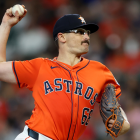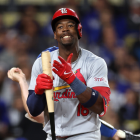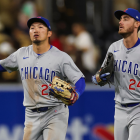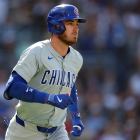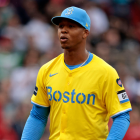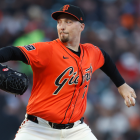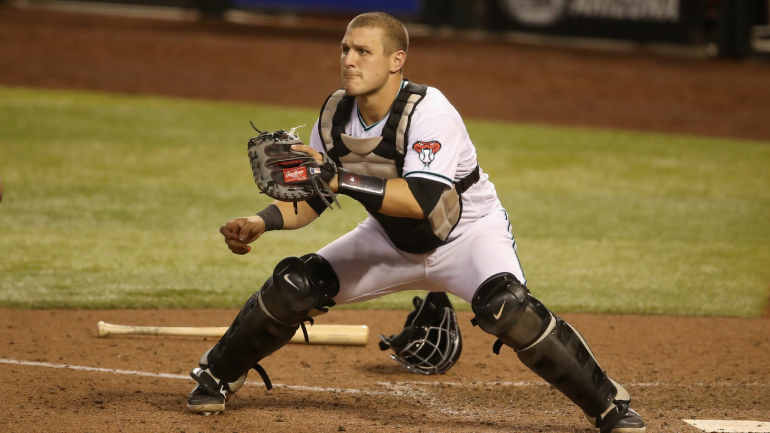
The arrival of the offseason means that it's time to rank stuff. Already this winter, we've sized up the 60 best free agents, both on an overall and positional basis. There's no law that prevents us from ranking minor-league players in addition to their big-league counterparts. As such, we're going to spend the winter evaluating every team's farm system.
The lack of a minor-league season makes that more of a challenge this year. It doesn't help that some teams opted against sharing video and data from their alternate-site camps with the rest of the league. As such, we've opted against overthinking this. Our rankings will essentially be the same as they were last winter with a few changes. First, we'll exclude anyone who graduated by exhausting their rookie eligibility; second, we'll replace them with draftees or other worthy prospects; and third, and lastly, we'll present the information in a new format.
In every article in this series, you'll find a team's top five prospects as well as five others we felt like including, either because of their promise or some other reason. For those top five prospects, you'll find a quick summation of their pros (their saving grace, if one will) and their cons (their fault line), as well as beefier report and our attempt to peg their "likeliest outcome."
These rankings were compiled by talking to industry folks -- scouts, analysts, and other evaluators -- and include a touch of our own evaluative biases. Remember, that this is more of an art than a science, and that the write-ups matter more than the rankings themselves.
Now, let's get on to the top five prospects in the Arizona Diamondbacks.
1. Kristian Robinson, OF
Age (as of 4/1/2021): 20
Height/Weight: 6-foot-3, 190 pounds
Acquired: International amateur free agent signing (Bahamas)
Highest level: Low-A
Saving grace: Impact potential
Fault line: Swing and miss
Scouting report: Robinson is one of the most intriguing prospects in the game. He possesses above-average raw power and speed, and his projectable frame should allow him to add more muscle. He's athletic enough to play center field for the time being, though any added weight could force him into a corner (likely right given that he has a strong arm). Robinson does swing and miss a lot, and he'll have to be mindful of striking out as he ascends the minors. The absolute ceiling here is star-level. It's anyone's guess as to whether he gets there.
Likeliest outcome: Slugging right fielder
2. Alek Thomas, OF
Age (as of 4/1/2021): 20
Height/Weight: 5-foot-11, 175 pounds
Acquired: Second-round pick in 2018 (Mount Carmel High School, Illinois)
Highest level: High-A
Saving grace: Performance-to-date
Fault line: Power/arm strength
Scouting report: As we noted last year, the main questions with Thomas are where he'll end up defensively and how much power he'll grow into. Because Thomas doesn't have a strong arm, the answer to the first part is either center or left field. As for the second part, it's important because the difference between the Sam Fulds and the Brett Gardners of the world is their ability to burn pitchers' mistakes. Without that, big-league arms are more likely to challenge them, to the extent that it suppresses their batting average and on-base percentage. Presuming Thomas does show enough pop to keep pitchers honest, he ought to be a top-of-the-order hitter and a decent to good glove wherever he lands on the grass.
Likeliest outcome: Leadoff-hitting corner outfielder
3. Daulton Varsho, C/OF
Age (as of 4/1/2021): 24
Height/Weight: 5-foot-10, 205 pounds
Acquired: Second-round pick in 2017 (Wisconsin-Milwaukee)
Highest level: MLB
Saving grace: Optionality
Fault line: Power
Scouting report: The Diamondbacks had Varsho catch and play outfield during his initial big-league stint. If they ask him to split time over a full season, he'll become the third player since World War II to appear at least 20 times in center field and behind the plate in a single season, joining Craig Biggio and Eli Marrero. For as much attention as Varsho's defensive home (or lack thereof) receives, it's easy to lose sight of his offensive abilities: he's a good runner with the chops to hit for average and walk. Varsho should see ample time in the majors in 2021.
Likeliest outcome: A multi-position regular with strong on-base skills
4. Corbin Carroll, OF
Age (as of 4/1/2021): 20
Height/Weight: 5-foot-10, 165 pounds
Acquired: Drafted 16th overall in 2019 (Lakeside School, Washington)
Highest level: Low-A
Saving grace: Bat, polish
Fault line: Size
Scouting report: As stupid as it sounds, if Carroll were a few inches taller he would probably be held in higher regards in prospecting circles. Instead, he seems likely to be underrated until he gets closer to the Show. That's a shame because there's enough precedent out there -- be it Mookie Betts, Andrew Benintendi, or Adam Eaton -- to prove that smaller outfielders can perform at a high level. Carroll, for his part, can run and should stick in center field over the long haul; at the plate, he profiles as a well-rounded batter who'll hit for average, walk, and yes, produce stronger power numbers than you might expect at first glance. There's a lot to like here, in other words, and discounting him based on his size is a mistake.
Likeliest outcome: Starting center fielder who contributes in every facet
5. Geraldo Perdomo, SS
Age (as of 4/1/2021): 21
Height/Weight: 6-foot-2, 180 pounds
Acquired: International amateur free agent signing (Dominican Republic)
Highest level: High-A
Saving grace: Precociousness
Fault line: Power, maybe
Scouting report: The Diamondbacks have traded away a couple of quality shortstop prospects in recent years, shipping out Jazz Chisholm and Liover Peguero in deals to acquire Zac Gallen and Starling Marte. Those departures have left Perdomo as the best shortstop prospect in the system, but don't confuse his ascent as a mere product of the aforementioned moves. Perdomo has shown an appreciable ability to hit despite being much younger than his average competition. Consider that he batted .301/.407/.387 in 26 High-A games in 2019 while being more than three years younger than the league-average player. Perdomo has a well-rounded skill set and his tall, lean frame suggests he could grow into more power. If he shows signs of adding pop in 2021, then expect him to move up this list come next winter.
Likeliest outcome: Regular shortstop
Five others to know
Blake Walston, LHP
Walston, the No. 26 pick in the 2019 draft, may have cracked the top five had anyone graduated. He'll have to settle for us describing him as one of the best pitching prospects in the system. He's a good athlete with a projectable frame and the makings of a well-rounded arsenal. Walston gained velocity after turning pro, and already has the feel for an above-average curveball. He'll need to work on the three C's of pitching (command, changeup, and consistency), but that's to be expected given that he turned 19 years old in June.Bryce Jarvis, RHP
The Diamondbacks had two picks in the top 50 in 2020. They used both on collegiate pitchers. Jarvis, No. 18, was first up. He's a hard worker who improved his velocity into the mid-90s during his time at Duke. He also has a high-grade changeup, one of the best in the class, and a solid slider. Jarvis will have to work on his command and his control, since he walked four or more batters per nine throughout his college career. He could be a mid-rotation starter.Slade Cecconi, RHP
Cecconi, a University of Miami product, was the second of those college arms; he went off the board at No. 33. Cecconi has the talent to make that pick a steal. He has a starter's frame and a pair of good pitches, in a fastball that can touch into the upper-90s and a swing-and-miss slider. He's had trouble with inconsistency in the past, and there's always concern when a pitcher's elbow lifts above their shoulder during the arm swing portion of their delivery.Corbin Martin, RHP
Martin hasn't pitched competitively since he tore his UCL a few weeks before being shipped to Arizona in the Zack Greinke trade. Provided he continues to make a full recovery, there's a chance that he makes his in-season organizational debut on a big-league mound. Martin, whose delivery resembles Mike Clevinger on decaf, has middle-of-the-rotation aspirations thanks to an arsenal that includes a high-spin mid-90s fastball, a pair of breaking balls, and a changeup.Pavin Smith, 1B/OF
Smith was taken seventh in the 2017 draft, ahead of Adam Haseley, Keston Hiura, and Jo Adell. Oopsie. Smith is unlikely to live up to his selection slot, and he's never going to be the typical slugging first baseman. He still might have a big-league career on the strength of his bat-to-ball and on-base skills, as he's adept at making a lot of contact and walking about as frequently as he strikes out. The Diamondbacks have experimented with him in the corner outfield to add to his versatility. He's already debuted and should see more big-league action in 2021.















